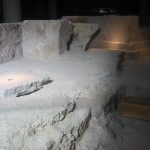The final will be celebrated in two days. Friday will be the rehearsal and Saturday, the concert
Edmon Levon, Luibov Nosova, Levente Török are the three finalists of the 1st “Llíria City of Music” International Orchestra Conducting Competition. They will compete to become the best young baton in Europe and rise with first prize.
The final phase will be celebrated within two different days: the rehearsal, Friday 16 July, and the concert, Saturday 17 July. Both parts will be held at the theatre Unión Musical de Llíria.
The repertoire chose for this phase includes Cantos, by the Valencian Francisco Coll, a premier for string orchestra; In quali eccessi o Numi de tradi quell’alma ingrata, recitative and aria from Don Giovanni; and the Coriolan Overture by Beethoven.
After the semi-final today, the jury has selected the candidates “in a phase of very high level. It has been really difficult to choose the three finalists because the six semi-finalists have proved great qualities on stage,” states artistic director of the competition Cristóbal Soler. “In a very few years, we will surely be able to see them conducting some of the most prestigious orchestras.”
The three finalists
Edmon Levon. He has trained as a conductor at the Royal Northern College of Music in Manchester, the Amsterdam Conservatory and the Royal Conservatory in The Hague.
He has conducted some of the important national orchestras such as the RTVE Orchestra, Orquesta de Extremadura, Orquesta de Córdoba and Orquesta Ciudad de Granada, and abroad, the BBC Philharmonic, Dutch Philharmonic, South Holland Philharmonic, The Hague Resident Orchestra, Jena Philharmonic, Hamburg Symphony and Moscow Philharmonic.
Moreover, he has been assistant conductor to Pablo González, Juanjo Mena, Antony Hermus or Yazco van Steen in orchestras such as the Royal Liverpool Philharmonic, the Berlin Radio Orchestra or the Finnish Radio Orchestra.
Liubov Nosova. She began her training with piano and organ studies at Rimsky-Korsakov’s College and at the Saint Petersburg Conservatory. Since 2017, she has participated in different conducting courses in the Czech Republic, Bulgaria, Spain and Russia with conductors such as Rodolfo Fischer, Johannes Schlaefli, James Lowe, Alim Schach or Vladimir Fedoseev, among others.
She has completed the Certificate of Advanced Studies in Zurich and is currently studying for a master’s degree at the Berlin University of the Arts.
In these years, she has conducted prestigious orchestras, among which are the Bochum Symphony, the Berlin Symphony, the Brandenburgisches Staatsorchester Frankfurt, the Brandenburger Symphoniker or the Moravian Philharmonic Orchestra.
Levente Török. After graduating in piano and composition at the Béla Bartók Music High School in Budapest, he studied conducting with Mark Stringer and Yuji Yuasa and repetition with Konrad Leitner at the University for Music and Performing Arts, Vienna.
Already with his 16 years he worked for the Opera Studio of the Hungarian State Opera, led by Géza Oberfrank. In the season 2014/15 he worked as “Assistant of the Chordirector” at the Vienna State Opera. Additionally, he has been assistant conductor of internationally recognized festivals such as the Bade-Baden Festival or the Wagner Festival Wels.
Since 2018 he is the First Conductor of the Theatre Ulm, Germany.
In 2019, he made his debut at the Hungarian State Opera.








